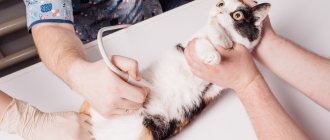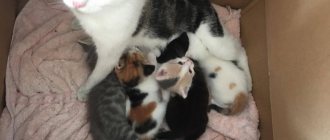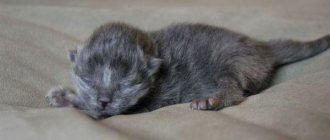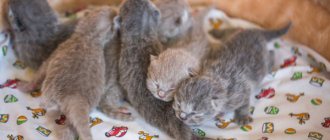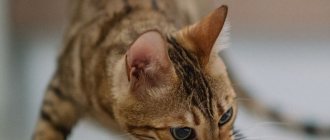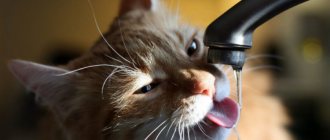The most popular pets are cats. Owners of purebred pets often breed kittens. In this difficult task, you cannot rely only on nature. The expectant mother needs to create comfortable conditions and provide proper care. That is why it is extremely necessary to know how long a cat’s pregnancy lasts and to thoroughly study all the intricacies of breeding.
First signs of pregnancy in a cat
How many months can a cat become pregnant? A cat's pregnancy can occur during the first heat cycle, which usually occurs as early as 6-7 months of age. It is from this age that it is necessary to be attentive to the animal and be on the alert.
Puberty may begin earlier, depending on the breed of the pet. For example, a Scottish and extreme cat is ready to become a mother from the age of 5 months, but veterinarians do not advise starting “adult” life at such a young age. Early birth can negatively affect the health of your pet.
The favorable age for the birth of offspring is determined by weight. In order for pregnancy and childbirth to be successful and without complications, the body weight of the expectant mother must be at least 2,300 kg. Most representatives of the feline family reach this parameter by 7-8 months.
You can determine the period of puberty in a cat by a characteristic sign - estrus. This process is also reflected in her behavior: she becomes truly sexy and excited, caresses her owners, gracefully arches her back, and purrs.
Added to these changes in the animal’s behavior is a protracted “song” at night. A cat can sit under the front door for a long time waiting for its betrothed and at the first opportunity jump out into the street in search of a suitable candidate.
Signs of cat pregnancy
Cats are ready to become mothers at 6-9 months. These are average data, since everything is purely individual and depends on many factors. For example, puberty occurs earlier in small and smooth-haired breeds than in large and long-haired ones. The timing differs depending on the pet’s health, the length of daylight hours, and even the time of year when the cat was born. Cats born in summer mature earlier than those born in winter.
For the first time, the sexual maturity of a female can be recognized by her characteristic behavior: she becomes hyper-affectionate, demanding attention and love. The cat meows invitingly, rubs against the furniture, arching its back. However, readiness for fertilization does not yet mean the physiological ability to bear kittens. This can only be determined by a veterinarian, who will advise whether the pet should look for a partner or postpone mating until next time.
Important! To exclude pathologies in the development of kittens and complications during pregnancy and childbirth in a cat, it is advisable to undergo an examination by a veterinarian. The doctor will rule out chronic diseases, the presence of infections that may complicate the process of pregnancy, and check the availability of necessary vaccinations.
What does a cat look like in position?
If mating has occurred, then the conception and occurrence of pregnancy can be judged by the following main signs:
- redness and swelling of the mammary glands: the nipples become engorged, they are characterized by swelling, often painful when touched;
- decreased activity, drowsiness, as the pet’s daily routine changes towards an increase in the period of sleep. The cat becomes less mobile, ignores active games;
- change in taste preferences. It is possible to refuse dry food, and increase fluid intake (broth, milk). Characterized by increased appetite;
- nausea is an optional but common symptom, especially in the morning. Possible vomiting;
- Mood swings from affection to aggression are explained by changes in hormonal levels.
From the fifth week, the pregnant female's abdomen noticeably stands out; in the sixth week, the kittens begin to move.
Note! You can definitely confirm the onset of pregnancy using ultrasound diagnostics at a veterinarian's appointment. It will accurately determine the presence of pregnancy, the estimated due date and how many kittens the cat is carrying in her stomach. On ultrasound, the fetal heartbeat is recognized already on the 24th day of gestation.
The owner can see the first signs himself
How is pregnancy progressing?
The further course of this important process is as follows:
- The first changes in the animal’s body will begin in the first couple of days after conception. Hormonal levels will quickly change, estrus will stop, and pregnancy will occur.
- Up to the first three weeks, you will determine the process by a good appetite, a tight belly, decreased activity and swollen nipples.
- The cat's belly will be visually noticeable already in the fifth week. It will not just be dense, but will sink significantly and grow in volume. This is especially noticeable if there are several fruits.
- After five weeks, the belly will expand. The lateral roundness will appear and will stick out.
- By the sixth week, the kittens are almost fully formed and begin to grow hair. You will only be able to see an increase in the abdomen.
- The kittens will become active in the seventh week and begin to move. If you gently, without pressing, put your hand on your stomach, you can feel how they move. During this period, the animal will look for a secluded place and become restless.
- The mammary glands will become engorged in the last week before birth, clear discharge from the genitals will appear, and activity will decrease significantly.
The most important period begins a few days before birth; the pet will need your presence. Nervousness and anxiety of the animal are clear signs of the imminent birth of kittens; the expectant mother will require the attention of the owner. Important! If a pregnant animal demands your attention, it's not just a whim. This behavior is explained by the fact that the cat perceives you as its owner and parent. The animal feels how the pregnancy is going - problematic or normal. Therefore, be patient and take utmost care.
How to determine pregnancy in a cat
If you didn’t keep track, and your indoor cat managed to run out into the street, now you need to figure out if she’s pregnant? This status can be determined by the following criteria:
- the cat calms down, stops asking to go outside and showing others its tender feelings with a sexual accent;
- increased appetite appears;
- after some time the animal confidently gains weight;
- The cat's nipples increase in size;
- Some animals develop toxicosis and may vomit;
- In the first weeks, the manifestation of aggression is also not excluded; the cat stops letting people approach it, tries to be alone and does not allow itself to be stroked again.
During the rest of the pregnancy period, the cat behaves more calmly, does not participate in active outdoor games and tries to fully conform to the image of a caring mother awaiting the birth of her furry babies.
Cat pregnancy
Animals have a strong reproductive instinct, but it turns on not just when, but precisely on the most suitable days for conception. Smart nature took care of the continuation of the feline race, so in the life of pets there is a “sexual season”, called the estrus period. A cat become about once every three weeks—the body gives the owner’s pet a chance to become a mother.
Few people can resist tiny kittens, especially if they are babies from their favorite cat. The time when the babies begin to run around the house is preceded by a fairly long period of pregnancy and the birth process. An attentive owner must understand all the difficulties of the gestation period, the health of the pet and the nuances of caring for the expectant mother.
Cat gestation period
The minimum period allotted by nature for a cat to become pregnant is 55 days, the maximum is 72 days.
According to the observations of owners, the average gestation time for a cat baby is 60-68 days. The gestation period of animals of different breeds varies, although slightly. Long-haired cats bear their offspring slightly longer than short-haired cats. For example, furry beauties from the Maine Coon breed have to wait 66-68 days for a happy moment, and representatives of the Siamese-Oriental group – only 59-64 days. Felinologists have determined the average duration of pregnancy for cats of different breeds. So, for example, it amounts to
- British Shorthair – 63-69 days,
- Scottish fold – 62-69 days,
- Bengal – 61-70 days,
- sphinx – 63-66 days,
- Somali and Abyssinian – 63-65 days,
- Persian - 63-66 days.
In cats bearing 1-2 cubs, the gestation period often reaches 72 days, and future mothers with many children can expect the appearance of offspring as early as 58 days.
The duration of gestation of kittens is often influenced by stressful situations for pregnant animals - moving, renovation, guests staying for a long time, noisy events. In such cases, childbirth may occur earlier or later than the moment established by nature.
Gestation period in cats
Every pet owner should know how long a cat stays pregnant. Why is it important:
- you need to prepare for the birth of kittens, create conditions in the house for comfortable labor and living of newborns;
- If the owner does not want to independently deliver the birth of his beloved pet, it is necessary to agree in advance with the veterinarian about the possibility of giving birth to kittens in a clinic.
How many days does a cat carry kittens: the average is 60-70 days.
From conception to birth, a cat's pregnancy is divided into six stages:
- The first 18-20 days pass relatively calmly, the cat does not show its new status in any way, with the exception of excessive appetite.
- From day 20, the second stage of pregnancy begins, lasting 10 days. The cat's belly becomes elastic, and the nipples swell noticeably. When examined in the clinic, the veterinarian can already feel the fruits.
- At 5 weeks of gestation, the belly grows noticeably. Prenatal kittens descend into the abdominal cavity. At this stage, you cannot palpate the cat’s belly, as this may be unsafe for future kittens.
- Weeks 5-6 are characterized by overly swollen sides. Babies no longer have enough space for a comfortable intrauterine existence.
- From 42 to 50 days are the most difficult for the animal. The cat may lose its appetite, and changes in character and behavior are possible. Aggression and anxiety are often visible. During this period, kittens already have full development, their length reaches 6-8 cm, and there is already fur on their body.
- The final sixth period: the babies are active, their movements in the stomach are visible even to the naked eye.
Well, and, of course, the final stage - childbirth and the birth of furry babies!
It is impossible to say unambiguously how many days a cat’s pregnancy lasts, because in these animals, like in people, these norms are relative and purely individual.
The gestation period also depends on the age of the cat, its breed and other important criteria. You need to prepare for the birth of kittens in advance, literally from the 58th day after conception you can expect an addition to the family.
Experienced breeders predict the following pregnancy periods for cats:
- long-haired representatives bear kittens for 62-72 days;
- Shorthaired cats have a slightly shorter gestation period, estimated to be 58-68 days.
If there are 1-2 kittens in the cat's womb, the pregnancy will be longer. You should expect an early birth if your cat has a multiple pregnancy.
The main reasons that affect the duration of pregnancy
Pregnancy in long-haired cats often takes longer - up to 72 days - than in smooth-haired, hairless breeds - up to 68 days.
Primiparous cats, unlike those who have already given birth, carry kittens for several days longer. A litter usually produces 3-8 kittens, but the fewer kittens, the more time the cat will be able to stay pregnant, and vice versa - if a cat has more than 5 kittens, she will probably give birth earlier.
At most, a cat's pregnancy can drag on for a week; if this happens longer, a veterinarian's examination is necessary. If the pregnancy is premature, the kittens may not survive.
The most important factor influencing a cat’s pregnancy is its internal state; stress delays the approach of birth.
Three weeks after conception, the cat's nipples turn pink, become rounded and erect, and she becomes less active and drowsy. The cat's appetite increases and its weight increases. Pregnancy also causes morning sickness.
If the mating took place under the control of the cat's owner, the date of conception is obvious - two days after the date of mating. But if nothing is known about the mating period, only a veterinarian can determine the exact gestational age of the cat. The owner can independently guess the approximate period based on the cat’s belly: with a large belly, the cubs are 8-9 weeks old, if the increase in the abdomen is not visible, and the nipples have become pink, most likely half of the kitten’s gestation period has passed.
How many months does a cat bear kittens?
Based on the normal gestation period for kittens (64-67 days), pregnancy in cats lasts for two months.
The entire period of cat pregnancy conventionally consists of three developmental phases, each lasting three weeks. During the first phase (1-21 days after conception), fertilization of eggs and development of embryos occurs: on the 15th day, the embryo grows to 10 mm, on the 18th day, the paws are formed, on the 21st day, the formation of internal organs occurs. At this time, the cat's nipples turn pink.
During the second phase (22-42 days after conception), the kittens’ skeleton and brain are formed, the endocrine system develops, and muscles appear. Kitten embryos become fetuses, taking on a feline appearance. They develop a muzzle and genitals.
In the third phase (43-63 days after conception), the kittens grow up to 8 cm, the tail grows, by the 45th day wool appears, acquiring color after 3 days, the kitten grows to 13 cm, by the 57th day the kitten is fully developed and is awaiting its birth .
A cat that does not have any health problems can give birth to healthy kittens on time. The genetic predisposition of a cat also affects the period of gestation of her cubs. The acceptable period for a cat's pregnancy is from 58 to 72 days, lasting about two months, which is the norm. Any deviation is pathology.
Signs
Despite the fact that it is almost impossible to immediately calculate the exact date of pregnancy, obvious signs of pregnancy in a cat can be determined already on the twentieth day.
The animal's nipples will enlarge and become bright pink. The skin around the nipples will begin to peel, this will become noticeable if you lay it on your back.
An experienced veterinarian can determine if a cat is pregnant by palpation in the third week. You should not try to palpate yourself, as this can harm the kittens and the health of your pet.
Early dates
You will notice that in the second week your pet becomes more thoughtful and melancholic. She plays less, sleeps longer, and her appetite also worsens. Already in the third week the animal may vomit. Don’t worry, this process also happens to women; in the first trimester they suffer from toxicosis.
After just five days, the vomiting goes away, and you can almost certainly determine pregnancy. Cats can also have a false pregnancy, which will go away on its own and will not require special treatment. It should be noted that if the false process occurs frequently, you should contact your veterinarian.
Late dates
Your pet will begin to gain weight in the 4-5th week, the weight will increase by one to two kilograms depending on the number of kittens. X-rays can show the skeletal structure of kittens at 44 days, but do not take an x-ray unless absolutely necessary.
The animal's taste preferences may also change and mood swings will appear. After a month and a half, the belly will increase even more, the cat will walk slowly, waddling.
After 8 weeks, the animal will begin to look for a place to give birth (“nest”), show anxiety and nervousness, during the same period you will be able to feel the active movements of the kittens by simply placing your hand on the pet’s stomach. Milk will appear in the mammary glands in the 9th week, and the animal will move less and lie down more; if there are a lot of kittens, pregnancy usually goes faster.
Important! Cats can have from one to ten kittens at a time; the reproductive organs of these animals are arranged differently: the cat’s uterus is shaped like the letter Y, it is much shorter than the human uterus and looks like a pear. Embryos are evenly attached to the processes of the uterus after fertilization, so multiple pregnancies do not harm the animal.
How long does a cat's pregnancy last?
Pregnancy in these animals lasts approximately 9 weeks. Varies from 55 to 63 days. Labor may begin a week earlier or later. It often happens that offspring are born earlier and still grow up healthy.
Pregnancy lasts different amounts of time for different breeds and types. Short-haired individuals bear offspring for 58–68 days, and long-haired individuals bear offspring for 62–72 days.
Labor begins earlier in the following cases:
- A large number of kittens in the litter (up to 57 days).
- Illness during position.
- Young individuals can give birth even on the fiftieth day (but in this case the offspring may be unhealthy).
- Small cats walk with a belly for no more than 65 days.
- Premature labor can begin when there is a sharp change in temperature.
- Weakly developed embryos die inside the animal, causing birth to occur earlier.
- Due to severe fright.
Childbirth will begin earlier if there are a large number of kittens in the litter
Causes of delay in labor:
- Small offspring.
- Stressful state before childbirth.
- Large and adult cats stay pregnant longer.
- Frozen pregnancy.
- Hypoxia of kittens.
Larger individuals bear offspring longer
An ultrasound can find out the exact cause of the delay.
Caring for a pregnant cat
Expert recommendations:
- Make sure that the cat does not climb to great heights and does not make dangerous jumps;
- do not leave alone at home for a long time, especially in the last days of pregnancy;
- do not let the cat go outside so that the cat does not give birth outside its home;
- create a healthy diet for your pet, consisting of natural foods rich in calcium, proteins and vitamin complexes;
- Half of the daily requirement in a cat’s menu should be lean meat;
- increase the number of feedings to 4-5 times;
- if your cat eats ready-made food, choose premium varieties that contain a rich complex of beneficial microelements;
- Make sure that there is always clean drinking water in the animal's bowl.
Following these simple care recommendations will allow your pet to safely bear offspring and give birth to healthy babies.
What should not be given to a pregnant animal?
- During pregnancy, a cat should not be wormed.
- It is also unacceptable to carry out flea baiting procedures.
- Do not give your pet medications and vitamin complexes without a doctor’s prescription.
- Don't feed your cat unhealthy foods.
Try not to touch the cat’s belly and under no circumstances press down, wanting to feel the future offspring.
Recommendations for caring for a pregnant cat
When tracking the development of the fetus in a pregnant cat week by week, it is necessary to remember that she does not need special care. But for a more comfortable process, it is still necessary to adhere to some rules:
- To ensure that the cat is not exposed to temperature changes, is not injured and does not come into contact with sick animals, its pregnancy should, if possible, proceed at home.
- If there are other animals in the house, including cats, the pregnant woman must be removed before giving birth.
- To prevent cross mating, sexual contact between the pregnant woman and the cat should not be allowed.
- For safety reasons for mom and babies, it is better not to allow her to climb onto high objects from which she could fall.
- All regular veterinary procedures (vaccinations, deworming) must be postponed until the postpartum period, when the cat is strong enough.
- Do not use chemically active substances near the expectant mother.
- Monitor the condition of the pregnant woman and, if there is a sharp deterioration in health, seek the help of a veterinarian.
- To keep the cat clean in the last weeks of pregnancy, it is necessary to wash it with warm water, especially carefully lingering on the tummy and nipples.
Sexual activity of cats during pregnancy
During pregnancy, cats' sexual activity decreases sharply. Due to changes in hormonal levels, they prefer not to get involved with members of the opposite sex.
Important! To protect your pet from premature birth, you should avoid any contact with cats.
Immediately after giving birth, you should wait a while with the next mating.
Pregnancy in cats usually proceeds without complications. But there are some breeds that have an increased risk of early or late births. To avoid this process, you should contact your veterinarian when pregnancy occurs. He will assess the animal’s condition and prescribe the necessary medications and nutrition. If necessary, he can come to the owner of the animal for delivery.
How to determine your due date
How do you know if it’s time for a cat to give birth or not? It is not at all difficult to recognize this important point, even if the owner, for certain reasons, does not take into account the length of the pregnancy.
Before labor begins, the cat’s instinct kicks in and she begins to actively look for a cozy place to give birth to her babies. The owner may notice how the pet carries various rags, things and toys to the selected corner.
Do not forbid her to carry out this training. Also, if possible, you should not move her from the chosen place; as an expectant mother, it is better for her to know where her newborn babies will be warm and comfortable.
Additional signs of imminent labor:
- the cat’s behavior changes, it may become aggressive or, conversely, overly affectionate;
- the animal’s body temperature decreases to 37 degrees;
- loss of appetite, cat refuses to eat;
- a day before the birth process begins, the animal begins to lick itself for a long time.
Childbirth takes place within a few hours. The maximum period is 1 day. If during this time the cat was unable to give birth on its own, it is necessary to take the pet to a veterinary clinic. This measure will make the birth process easier and reduce the risk of complications.
Possible pathologies
Although pregnancy is a physiological condition, as it develops, the load on the body also increases; the heart, kidneys, lungs, liver, intestines are under attack, and pressure on the abdominal walls increases.
A healthy animal tolerates all transformations well, but under certain negative conditions, physiology can develop into pathology, which not only threatens the life of the fetus, but also complicates the course of pregnancy itself and subsequent births.
Pregnant cats may experience:
- uterine inguinal hernia - protrusion of the uterus with fetuses through the inguinal canal;
- bleeding - blood leaking from the uterus can cause placental abruption;
- polyhydramnios - accumulation of fluid in the amniotic membranes, most often diagnosed in the last weeks of pregnancy;
- torsion of the uterus - occurs due to an unsuccessful fall, blows to the stomach, jumping from a height, etc.;
- Abortion is the death of fetuses followed by their expulsion from the uterus.
Important! Any deterioration in the condition of a pregnant female requires immediate intervention from a specialist.
An urgent visit to a veterinary clinic is necessary if your pet exhibits at least one of the following symptoms:
- the presence of a protrusion between the last and penultimate pair of nipples, which was not there before;
- discharge of blood or clots from the genital opening;
- the animal is worried: gets up, lies down, gets up again;
- weakness, apathy, poor appetite are observed;
- the belly at the end of pregnancy suddenly grows rapidly, takes on a barrel-shaped shape, the genital loop is red and swollen;
- the peritoneum is tense, the back is hunched, it is difficult for the cat to stand, it is difficult to lie down;
- a miscarriage occurred.
In very rare cases, a “double” pregnancy is observed, when the animal, after fertilization, comes into heat again and fertilization occurs. The outcome depends on many factors: in one case, later offspring die during the birth of earlier offspring, in others, a few weeks after the first birth, the second will occur, and all kittens will be healthy.
Drowsiness during pregnancy
Factors on which the period depends
How long a cat will walk while pregnant depends on many factors: its breed, age, condition, number of kittens, etc.
Breed
A pattern has been revealed that long-haired cats bear litter longer than short-haired cats. In the first case, the period is 52-73 days. In the second - 59-69. This is due to the genetic code.
- For the British breed, the usual gestation period is 63-70 days. The more kittens, the longer the term. Genetics also plays a role: as long as the pregnant mother walked, the daughter will walk as long.
- Scottish ones give birth after 62-67 days. In rare cases, the period may increase by five days and for them this is considered normal.
- The Persian cat bears kittens for 63-68 days. The lifespan is individual for each animal and is influenced by genetic and other factors.
- Siamese cats spend the longest time pregnant - 65-72 days.
We recommend reading the article about discharge in a pregnant cat.
Number of offspring
The more it is, the shorter the duration of gestation. This is due to the area of the abdominal cavity and transplacental feeding. If there are many kittens, then they “do not fit” and birth occurs earlier.
Age
Older animals carry kittens longer. Old cats have a slower metabolism, which causes embryos to develop less well. This also applies to individuals in poor health.
Emotional condition
With nervous disorders, the gestational age increases by several days.
Cat giving birth
Cats can give birth on their own; after the birth of the first kitten, they gnaw the umbilical cord and wash their baby. Kittens are born in a bubble, which is also successfully burst by the cat.
If for some reason the animal was unable to free its kitten from this dome, make a careful tear to free it, otherwise it may suffocate. After giving birth, the cat, like a caring mother, will feed her babies and monitor their hygiene.
Your task:
- create a safe atmosphere in the home for newborns to live;
- organize a healthy diet for the cat so that she can feed her babies good milk;
- Do not handle newborn kittens for at least a couple of weeks after birth.
How many times a year can a cat give birth: for purebred animals, this norm is established - once every 10 months.
How does childbirth occur in cats?
Childbirth in British cats occurs differently. Much depends on the individual characteristics of the body, body type and many other factors. However, there are a number of characteristic features that every owner should be aware of.
The first sign of impending labor is the release of the birth plug. Often this process goes unnoticed by the owners, since cats tend to hide this pinkish clot. So you have to navigate by the receding waters.
How childbirth occurs in cats - watch the video:
If this happens, then there is very little time left before the appearance of cat offspring. Typically, a cat does not require human assistance during birth. However, if she reaches out to her owners, it means that she needs to be supported and calmed with light stroking.
The first stage of labor begins with contractions, which help dilate the cervix. At this moment, the fetus is already beginning to pass through the birth canal. How to detect contractions in a cat? In most cases they are visible visually. In addition, the cat is quite restless during contractions and meows a lot.
She is in pain, so the owners need to try to calm the animal down. At the second stage, the kitten is born. Often, fluid comes out of the birth bladder first. Then the cub itself appears. Usually kittens enter head first, but if it happens differently, then this is also not a pathology. However, in such a situation, the cat and baby may need human help.
At the last stage, the uterus comes to a calm state and the so-called afterbirth comes out. This is followed by a short break, after which the process of giving birth to the next kitten begins. This break usually lasts from 10 minutes to an hour.
Sometimes it happens that after the birth of several cubs, the birth of a British cat is interrupted. At the same time, the young mother behaves completely naturally, taking care of the already born offspring. However, after some time, labor continues and the remaining kittens are born. For cats, such breaks are quite normal. But it’s worth keeping an eye on your pet at this time. The duration of such physiological rest can vary from 12 to 36 hours.
And a few words about the afterbirth. Usually cats eat it. However, you should not let your pet do this more than twice. Otherwise, the new mother may experience vomiting or diarrhea. In addition, you should make sure that all the placenta comes out (according to the number of kittens).
If this does not happen, then you must consult a specialist so that the cat does not develop internal inflammation.
How many months does a cat bear kittens?
How long do pregnant cats walk: the approximate period for adults is 9 weeks (2.5 months). This date can be easily calculated. This indicator may differ up or down by 5-7 days from the moment when the pet was able to become pregnant. This depends on many factors, including the living conditions of the animal.
Premature babies are born weak and may have diseases. In some cases they are not viable. If a pregnant cat postpones the term, this also adversely affects the growth and formation of the fetus. Hypoxia occurs, that is, lack of oxygen. As a result, brain defects may occur.
For reference: if the cat is a yard cat, the process of delivery may begin earlier, as it is affected by weather conditions (severe frosts) and stress.
In some cases, premature kittens are born completely healthy. This happens when the owner takes good care of his animal, feeds it properly and creates all the favorable conditions.
Nipple enlargement
How many kittens do cats bear?
How long after giving birth can a cat become pregnant?
After mating, every owner is curious about how many months later a cat gives birth to kittens. The average period is 9 weeks or 62 days. These are statistical numbers. The actual period depends on the number of cubs, the cat’s physique, and its age. In multiple pregnancies, kittens may be born premature. The length of time a first-time cat bears kittens and during repeated births also differs: the older she is, the longer she bears.
There is a relationship between the duration of pregnancy and the origin of the pet. The length of pregnancy for purebred cats differs from the duration of pregnancy for domestic cats. Different breeds of cats differ in the duration of pregnancy; long-haired cats have a longer gestation period.
Duration depending on breed:
- sphinxes - 64-66 days;
- Scottish Fold - 63-70 days;
- British shorthair (British) - 64-70 days;
- Maine Coons - 65-68 days;
- Siamese - 59-65 days;
- Persian - 63-66 days;
- Abyssinian - 64-66 days;
- Bengal - 60-70 days.
How many days does pregnancy last
How long it takes for outbred cats to kitten depends on their living conditions, sufficiency of food, and the presence of stressful situations. The number of births they have can reach three per year, but this greatly depletes the cat’s body and shortens its life expectancy. Veterinarians do not recommend breeding domestic cats more than once a year.
Important! If there is no desire to have offspring from a pet, then the cat should be sterilized at the age of 7-8 months, when it is still essentially a child. It is strictly not recommended to carry out sterilization during pregnancy. This can lead to bleeding and a long recovery time after surgery.
Characteristic signs and “surprises” of the first cat pregnancy
The optimal age for a cat to become pregnant for the first time is over a year. The veterinarian can determine the special position of the purr by visual examination approximately 20 days after fertilization has occurred, when the kittens are no larger than the size of a peanut. Using an ultrasound, he will establish pregnancy in the second week.
But there are signs by which owners may also suspect that the cat is soon expecting an addition to the family. In the third week from conception, her nipples turn pink and enlarge, which is especially noticeable if this is her first pregnancy.
During the first 3-4 weeks, her activity noticeably decreases. She may have nausea and vomiting in the morning (due to hormonal changes and stretching of the uterus), but this will soon pass. Then the expectant mother will begin to sleep and eat more. She will become slower and will often be in a state of thoughtfulness. Her food preferences may change.
Around the sixth week, pregnancy will already become obvious, and at 7 weeks, if you put your palm on her tummy, you will be able to feel the kittens moving.
On a note! These pets often have non-simultaneous births of cubs, when several of them are born within one day, and the rest after 24 - 48 hours.
Stages of pregnancy
The process of bearing kittens is divided into three stages, each of which lasts an average of three weeks.
Fertilization
How many days does a cat walk: examples for the first time and how long in time
Fertilization is the fusion of a sperm with an egg. In a cat, fertilization occurs as a result of successful mating. The result is the formation of a zygote - an embryo. The zygote actively divides for the first few days, and then attaches to the uterine mucosa. After implantation, the embryo actively divides. This period is very important for the proper formation of the fetus, since all the main vital systems of the kitten’s body are formed. At this time, the cat is already showing the first visual signs of pregnancy, and by day 21 an experienced doctor can determine the presence of babies by palpation.
Development
At the second stage, the active development of future kittens continues, tissues differentiate, and organs form. By the end of the fifth week, the fetus has fully formed body parts and reaches a size of 25-40 mm. The pet's appetite noticeably increases and she gains weight. The cat's belly grows and takes on a pear shape. At this time, she needs to be protected from stress, ensure that she does not jump from great heights, and create a pleasant psychological atmosphere. It is strictly forbidden to raise a hand to her.
Important! At this time, it is vital for the full development of the fetus to provide the expectant mother with all the necessary nutrients, vitamins and microelements.
Prenatal
At the final stage, the formation of the fetus is completed, the kitten’s body prepares for birth. The size reaches 60-90 mm, all organ systems begin to function, and hair forms. The naked eye can see the kittens moving in their stomachs. The cat's maternal instinct awakens. If there are children in the house, she prefers their company. In the last week before giving birth, the cat’s behavior changes: its appetite decreases, it becomes restless and irritable, and looks for a place in the house where it can safely calve.
Fetal development
To eliminate the possibility of childbirth in unsanitary conditions, it is better to temporarily isolate and close hard-to-reach places. It makes sense to arrange a separate place. A good option would be a chest of drawers or a cardboard box of impressive size, located in a dark and quiet place. At the bottom you need to lay woven material (an old sheet, a rug), which you won’t mind throwing away.
